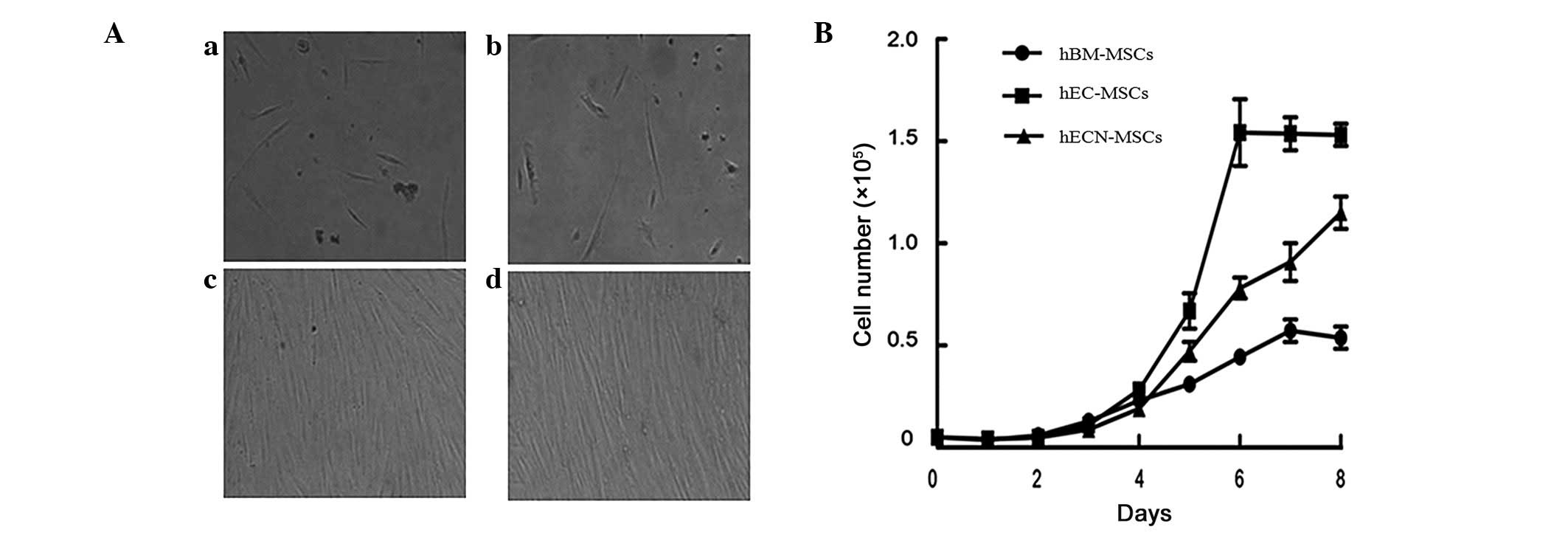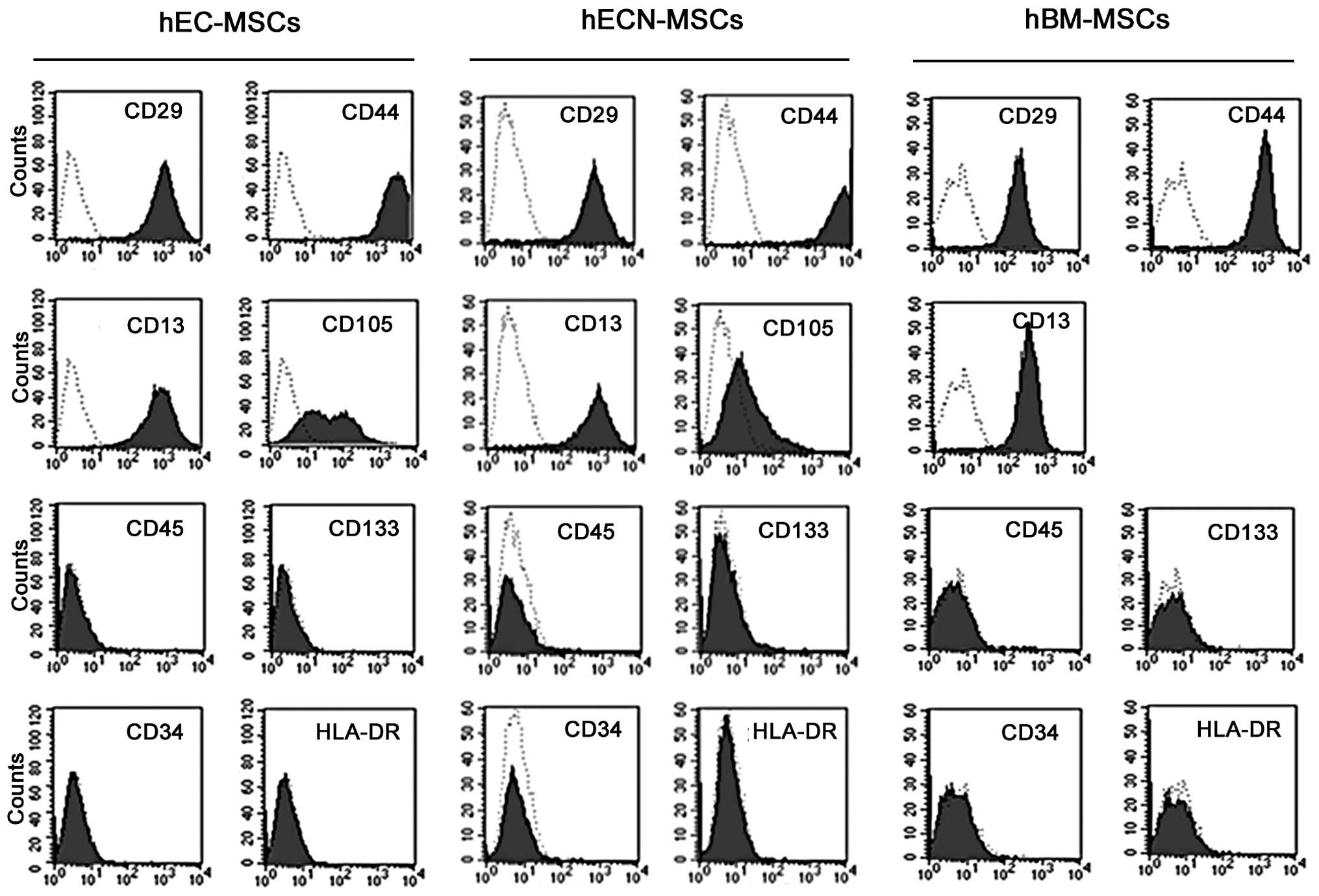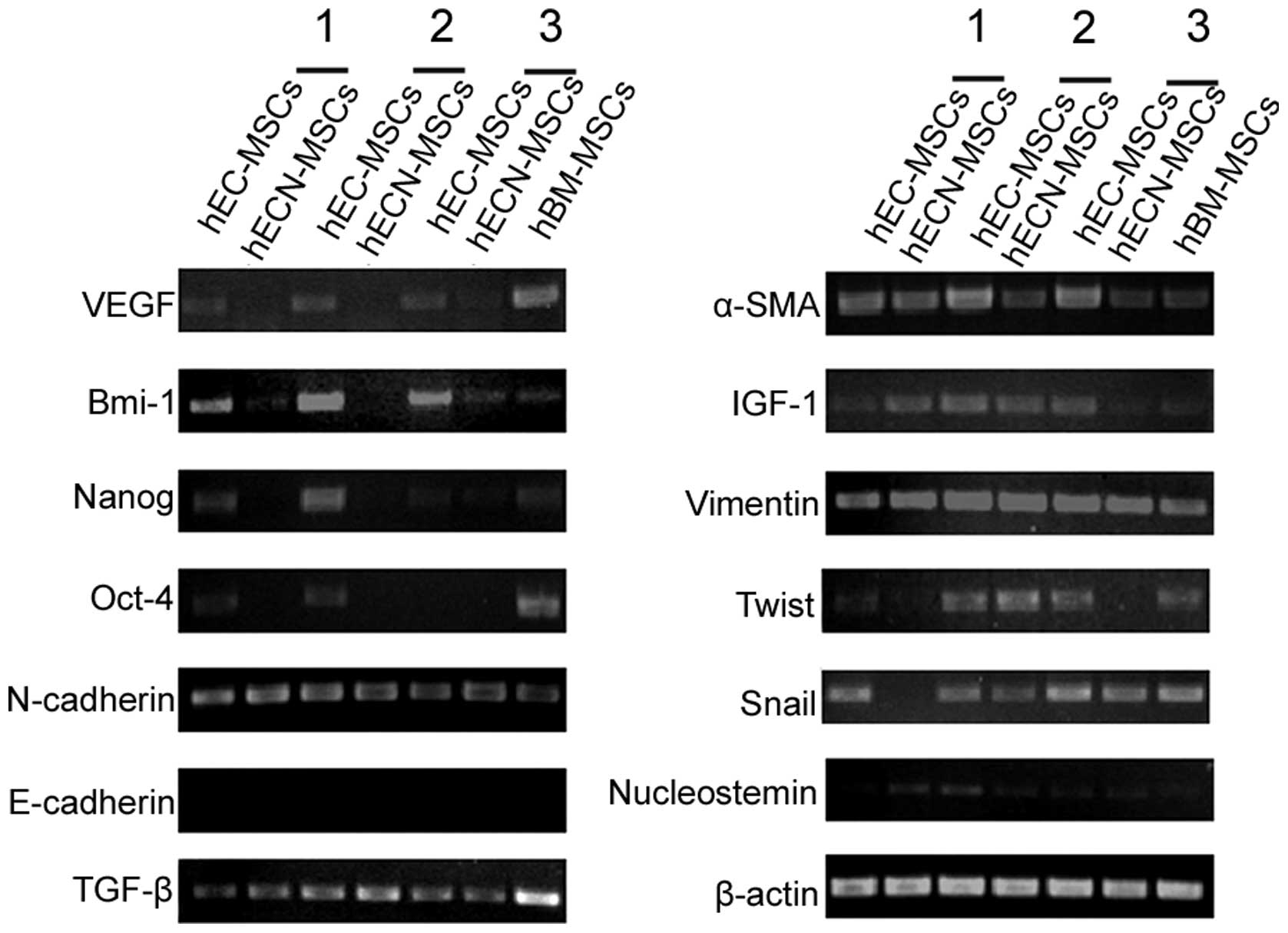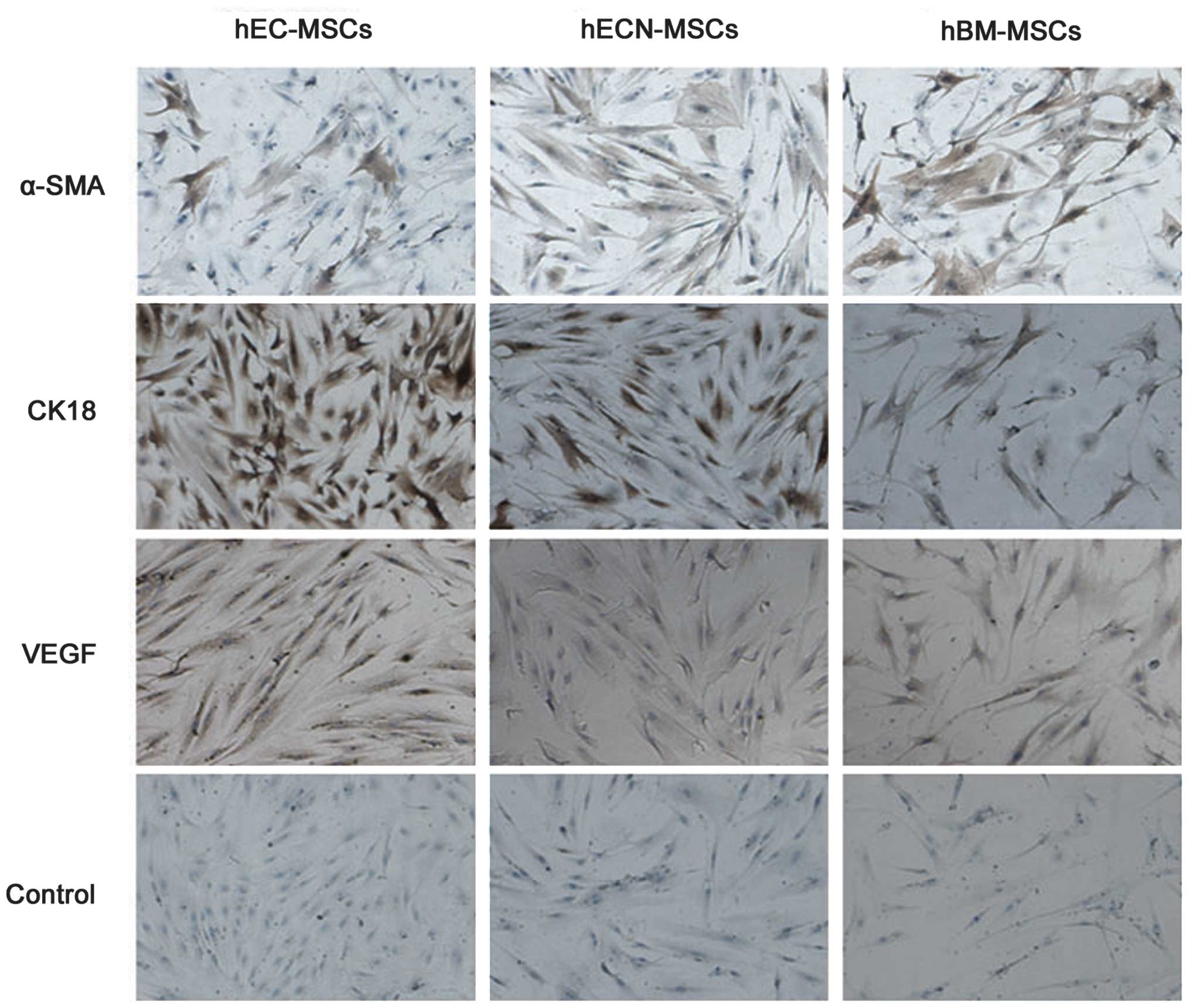Mesenchymal stem-like cells isolated from human esophageal carcinoma and adjacent non-cancerous tissues
- Authors:
- Published online on: October 30, 2012 https://doi.org/10.3892/ol.2012.1003
- Pages: 179-184
Abstract
Introduction
Mesenchymal stem cells (MSCs) are non-hematopoietic stromal cells that are a heterogeneous population of cells which are able to proliferate in vitro as plastic-adherent cells. They have fibroblast-like morphology, form colonies in vitro and are capable of differentiating into bone, cartage and fat cells (1). It has been shown that MSCs have the propensity to migrate to sites of injury and disease (2,3). Due to their multi-differentiation potential and migratory capacity, MSCs are regarded as ideal candidates for regenerative therapy or tissue engineering.
In addition to bone marrow, MSCs and MSC-like cells have now been isolated from various sites, including adipose tissue, amniotic fluid, periosteum and fetal tissues, and show phenotypic heterogeneity (4–10). With the recent developments of research, it has also been reported that MSCs and MSC-like cells may be isolated from certain non-solid tumors, such as lipoma and bone sarcoma, and solid tumors, such as gastric and uterine cervix cancer (11–14). The study of the correlation between MSCs or MSC-like cells and tumors is ongoing. Whether MSCs inhibit or promote the growth or development of tumors has been a controversial topic and there have been many opposing reports in the past few years (15–17). At the same time, the biological characteristics of MSCs and MSC-like cells in different tissues have also been studied extensively (18–21).
In this study, we attempted to locate and isolate MSC-like cells from human esophageal squamous cell carcinoma tissues (hEC-MSCs) and adjacent non-cancerous esophageal tissues (hECN-MSCs) and compare their biological characteristics so as to build a foundation for further study of the microenvironment and pathological mechanisms of esophageal carcinoma in the future.
Materials and methods
Isolation of hEC-MSCs and hECN-MSCs
A total of 25 paired primary esophageal carcinoma tissues and adjacent non-cancerous esophageal tissues were collected from April 2010 to January 2011 at the Department of Thoracic Surgery, the Affiliated Hospital of Jiangsu University, China. There were 22 male and 3 female patients ranging from 49 to 73 years old (median, 60 years). None of the patients received adjuvant radiation or chemotherapy prior to surgery. Specimens used in this study were approved by the Ethical Committees of Jiangsu University. Written informed consent was obtained from the patient. The fresh esophageal carcinoma tissue and its paired non-cancerous esophageal tissue were collected and washed with phosphate-buffered saline (PBS). The tissues were cut into 1–3 mm3-sized sections, then digestion with 0.1% collagenase type IV (Sigma, St. Louis, MO, USA) was performed at 37°C for 30 min. The suspension was centrifuged at 800 rpm for 5 min. Centrifugal precipitates were washed twice, then resuspended in Dulbecco’s modified Eagle’s medium (DMEM) containing 15% fetal bovine serum (FBS) on 35 mm culture dishes, and incubated at 37°C with 5% CO2 for 30 min. After removing the non-adherent cells, the remaining cells were left to incubate for 1–2 weeks (22). The adherent cells were then trypsinized and passaged into a new culture flask at a ratio of 1:3 for further expansion. The cells were used for subsequent experimental study at the third passage.
Cell growth curves
The cell growth curves were determined by cell counting at a regular time every day. hEC-MSCs, hECN-MSCs and MSC-like cells at the third passage from human bone marrow (hBM-MSCs) (23) were seeded in 24-well plates at a density of 5×103 per well during the logarithmic growth phase. The number of adherent cells per well was counted on days 1–8 of culture, and the procedure was repeated three times.
FACS analysis
For the FACS analysis, hEC-MSCs, hECN-MSCs and hBM-MSCs were trypsinized. After being rinsed twice with PBS, 1×106 cells were incubated with specific PE-conjugated antibodies against CD13, CD29, CD44, CD45, CD105 (for hEC-MSCs and hECN-MSCs) and CD133, FITC-conjugated antibodies against CD34 and HLA-DR (Becton-Dickinson, San Jose, CA, USA) in 250 μl PBS for 30 min. After being rinsed with PBS, the labeled cells were analyzed using FACSCalibur. PE-IgG1 and FITC-IgG1 were used as controls.
RT-PCR
To compare differentially expressed genes between hEC-MSCs and hECN-MSCs, total RNA was extracted using TRIzol (Invitrogen, Carlsbad, CA, USA) according to the manufacturer’s instructions, and cDNA was generated using Reverse transcriptase II and Oligo-dT primer (Toyobo, Japan) according to the manufacturer’s instructions. RT-PCR was performed with the following temperature profile: a pre-denaturation step of 5 min at 94°C, followed by 35 cycles of 94°C for 30 sec, annealing temperature for 30 sec and 72°C for 30 sec and a final exposure to 72°C for 10 min. β-actin was used as a control and the specific primers are listed in Table I.
Immunohistochemistry
For immunohistochemical staining, the streptavidin-biotin-peroxidase complex method was used to detect the proteins. hEC-MSCs, hECN-MSCs and hBM-MSCs were fixed with 4% paraformaldehyde at room temperature and endogenous peroxidase activity was quenched and blocked with hydrogen peroxidase (30% H2O2 and methanol, 1:50) for 30 min and 5% BSA for 20 min. The cells were sequentially incubated with primary antibodies for α-SMA, CK18 and VEGF (Boster, Wuhan, China) for 80 min, followed by biotin-labeled anti-rabbit or anti-mouse secondary antibody (Boster) for 20 min at 37°C, and developed with 3,3′-diaminobenzidine (Boster). For negative controls, the conditions were identical except that primary antibodies were replaced by PBS.
Statistical analysis
Statistical analysis carried out using SPSS standard version 13.0 software. Data are reported as the mean ± SD from at least three independent tests. Significance of difference was analyzed using the Student’s t-test. P<0.05 was considered to indicate a statistically significant result.
Results
Morphology and growth characteristics of hEC-MSCs and hECN-MSCs
hEC-MSCs and hECN-MSCs were successfully isolated by collagenase digestion. A small quantity of long spindle-shaped cells were found after 3–4 days of primary culture, and the cells reached 80–90% confluence after 15–20 days of primary culture. hEC-MSCs and hECN-MSCs had a similar morphologically and were long and spindle-shaped (Fig. 1A). The growth curves of hEC-MSCs and hECN-MSCs showed that hEC-MSCs grew faster than hECN-MSCs in the same culture conditions after 5 days of culture (P<0.05). hBM-MSCs were used as a control (Fig. 1B).
Expression of surface antigens
FACS analysis demonstrated that hEC-MSCs and hECN-MSCs expressed the typical MSC surface antigens. hBM-MSCs served as a control (Fig. 2).
Gene expression in hEC-MSCs and hECN-MSCs
RT-PCR results showed that hEC-MSCs and hECN-MSCs expressed stem cell-related genes, including Oct-4, Nanog, Bmi-1 and Nucleostemin, and stroma cell-related genes, including TGF-β, Vimentin, Twist, α-SMA and Snail. However, the expression levels of VEGF, Bmi-1, Nanog and Oct-4 were higher in hEC-MSCs than in hECN-MSCs between the three pairs of hEC-MSCs and hECN-MSCs. Neither hEC-MSCs nor hECN-MSCs expressed E-cadherin. hBM-MSCs served as a control and β-actin was used as a housekeeping gene (Fig. 3).
Immunohistochemical staining of hEC-MSCs and hECN-MSCs
The results of immunohistochemical staining showed that the protein expression levels of CK18 and VEGF were higher in hEC-MSCs than in hECN-MSCs, while the expression level of α-SMA was similar between hEC-MSCs and hECN-MSCs (Fig. 4).
Discussion
As essential components of tumor stroma cells, MSCs play an important part in the tumor microenvironment which modulates tumor growth and development in a number of ways. MSCs are able to become tumor-associated fibroblasts (TAFs) or carcinoma-associated fibroblasts (CAFs) which contribute to fibrovascular network expansion and tumor progression (24,25). They are also capable of differentiating into pericytes and mural cells around tumor blood vessels, which contribute to the formation of a mature vasculature in tumors (26).
MSCs in tumor tissue are generally believed to be stem cells from bone marrow (27). Strong evidence demonstrates that MSCs are able to home to injury sites in a number of pathological conditions, including inflammation, tissue repair and neoplasia (2,3,28). During progression and development of tumors, MSCs can be recruited in large numbers to the tumor site (29).
In the present study, we successfully isolated five paired hEC-MSCs and hECN-MSCs from 25 paired primary esophageal squamous cell carcinoma tissues and adjacent non-cancerous esophageal tissues. The cells presented a typical long spindle shape. The cell growth rate of hEC-MSCs was significantly higher than that of paired hECN-MSCs. Our results indicated that hEC-MSCs and hECN-MSCs expressed CD13, CD29 and CD44, weakly expressed CD105, but did not express CD34, CD45, CD133 and HLA-DR, which was also similar to hBM-MSCs according to our previous studies (23).
To explore the role of hEC-MSCs and hECN-MSCs in tumor development and progression, gene expression was compared between them by RT-PCR. Among the 13 known genes, Oct-4, Nanog, Bmi-1 and Nucleostemin were associated with stem cells, while N-cadherin, TGF-β, Vimentin, Twist, α-SMA and Snail were associated with stromal cells. Previous studies have shown that the expression of Oct-4 and Nanog was at a higher level in certain epithelial malignant tumors compared with corresponding cancer-adjacent tissues and normal tissues (30,31). Similarly, Bmi-1 was reported to have low expression or even no expression in cancer-adjacent and normal tissues, but its expression was significantly higher in tumor tissues, and was associated with poor prognosis in patients (32,33). VEGF promotes the formation of new blood vessels in tumors, which plays an important role in the growth, invasion and metastasis of tumors (34,35). In our study, the expression levels of VEGF, Bmi-1, Nanog and Oct-4 were notably higher in hEC-MSCs than in hECN-MSCs.
Moreover, the results of immunohistochemistry showed that the protein expression levels of α-SMA and VEGF were correlated with the corresponding gene expression levels. The expression level of CK18 in hEC-MSCs was also higher than in hECN-MSCs. CK18 is a cytokeratin, and is a specific marker of epithelial cells. Research has shown that the expression level of CK18 is closely correlated with the malignant degree of cells. It was lower in normal epithelial cells than in tumor epithelial cells, and the expression level increases with the degree of malignancy (36,37).
In conclusion, our study showed that MSC-like cells may be successfully isolated from human esophageal carcinoma and adjacent non-cancerous esophageal tissues. The study may lay the foundations for further research on the esophageal carcinoma microenvironment and its mechanism of development.
Acknowledgements
This study was funded by the Startup Foundation for Advanced Talents, Jiangsu University (No. 9JDG037) and the National Natural Science Foundation of China (No. 31071421).
References
|
Horwitz EM, Le Blanc K, Dominici M, et al: Clarification of the nomenclature for MSC: The International Society for Cellular Therapy position statement. Cytotherapy. 7:393–395. 2005. View Article : Google Scholar : PubMed/NCBI | |
|
Natsu K, Ochi M, Mochizuki Y, Hachisuka H, Yanada S and Yasunaga Y: Allogeneic bone marrow-derived mesenchymal stromal cells promote the regeneration of injured skeletal muscle without differentiation into myofibers. Tissue Eng. 10:1093–1112. 2004. View Article : Google Scholar | |
|
Rojas M, Xu J, Woods CR, Mora AL, Spears W, Roman J and Brigham KL: Bone marrow-derived mesenchymal stem cells in repair of the injured lung. Am J Respir Cell Mol Biol. 33:145–152. 2005. View Article : Google Scholar : PubMed/NCBI | |
|
In’t Anker PS, Scherjon SA, Kleijburg-van der Keur C, et al: Amniotic fluid as a novel source of mesenchymal stem cells for therapeutic transplantation. Blood. 102:1548–1549. 2003.PubMed/NCBI | |
|
Nakahara H, Dennis JE, Bruder SP, Haynesworth SE, Lennon DP and Caplan AI: In vitro differentiation of bone and hypertrophic cartilage from periosteal-derived cells. Exp Cell Res. 195:492–503. 1991. View Article : Google Scholar : PubMed/NCBI | |
|
Zuk PA, Zhu M, Ashjian P, et al: Human adipose tissue is a source of multipotent stem cells. Mol Biol Cell. 13:4279–4295. 2002.PubMed/NCBI | |
|
Kim SM, Lim JY, Park SI, et al: Gene therapy using TRAIL-secreting human umbilical cord blood-derived mesenchymal stem cells against intracranial glioma. Cancer Res. 68:9614–9623. 2008. View Article : Google Scholar : PubMed/NCBI | |
|
Bieback K and Kluter H: Mesenchymal stromal cells from umbilical cord blood. Curr Stem Cell Res Ther. 2:310–323. 2007. View Article : Google Scholar : PubMed/NCBI | |
|
Flynn A, Barry F and O’Brien T: UC blood-derived mesenchymal stromal cells: an overview. Cytotherapy. 9:717–726. 2007. View Article : Google Scholar : PubMed/NCBI | |
|
Gucciardo L, Lories R, Ochsenbein-Kölble N, Done’ E, Zwijsen A and Deprest J: Fetal mesenchymal stem cells: Isolation, properties and potential use in perinatology and regenerative medicine. BJOG. 116:166–172. 2009. View Article : Google Scholar : PubMed/NCBI | |
|
Lin TM, Chang HW, Wang KH, et al: Isolation and identification of mesenchymal stem cells from human lipoma tissue. Biochem Biophys Res Commun. 361:883–889. 2007. View Article : Google Scholar : PubMed/NCBI | |
|
Gibbs CP, Kukekov VG, Reith JD, et al: Stem-like cells in bone sarcomas: implications for tumorigenesis. Neoplasia. 7:967–976. 2005. View Article : Google Scholar : PubMed/NCBI | |
|
Xu X, Zhang X, Wang S, et al: Isolation and comparison of mesenchymal stem-like cells from human gastric cancer and adjacent non-cancerous tissues. Cancer Res Clin Oncol. 137:495–504. 2011. View Article : Google Scholar : PubMed/NCBI | |
|
Sun X, Cai H, Qian H, Zhu W, Yan Y, Xu H and Xu W: Mesenchymal stem cells isolated from human uterine cervix cancer tissues. Cell Biol Int. 35:119–123. 2011. View Article : Google Scholar : PubMed/NCBI | |
|
Khakoo AY, Pati S, Anderson SA, et al: Human mesenchymal stem cells exert potent antitumorigenic effects in a model of Kaposi’s sarcoma. J Exp Med. 203:1235–1247. 2006.PubMed/NCBI | |
|
Xu WT, Bian ZY, Fan QM, Li G and Tang TT: Human mesenchymal stem cells (hMSCs) target osteosarcoma and promote its growth and pulmonary metastasis. Cancer Lett. 281:32–41. 2009. View Article : Google Scholar : PubMed/NCBI | |
|
Ahmed N, Abubaker K, Findlay J and Quinn M: Epithelial mesenchymal transition and cancer stem cell-like phenotypes facilitate chemoresistance in recurrent ovarian cancer. Curr Cancer Drug Targets. 10:268–278. 2010. View Article : Google Scholar : PubMed/NCBI | |
|
Moon JH, Kwak SS, Park G, et al: Isolation and characterization of multipotent human keloid-derived mesenchymal-like stem cells. Stem Cells Dev. 17:713–724. 2008. View Article : Google Scholar : PubMed/NCBI | |
|
Bruno S, Bussolati B, Grange C, et al: Isolation and characterization of resident mesenchymal stem cells in human glomeruli. Stem Cells Dev. 18:867–879. 2009. View Article : Google Scholar : PubMed/NCBI | |
|
Mitrano TI, Grob MS, Carrión F, et al: Culture and characterization of mesenchymal stem cells from human gingival tissue. J Periodontol. 81:917–925. 2010. View Article : Google Scholar : PubMed/NCBI | |
|
Schüring AN, Schulte N, Kelsch R, Röpke A, Kiesel L and Götte M: Characterization of endometrial mesenchymal stem-like cells obtained by endometrial biopsy during routine diagnostics. Fertil Steril. 95:423–426. 2011.PubMed/NCBI | |
|
Zhou ZW, Hu JB, Shi SB, Zhu XZ, Wang XH and Xu WR: Isolation of mesenchymal stem-like cells from human esophageal carcinoma and identification of their biological characteristics. Basic Clin Med. 32:798–803. 2012. | |
|
Xu W, Zhang X, Qian H, et al: Mesenchymal stem cells from adult human bone marrow differentiate into a cardiomyocyte phenotype in vitro. Exp Biol Med. 229:623–631. 2004.PubMed/NCBI | |
|
Spaeth EL, Dembinski JL, Sasser AK, et al: Mesenchymal stem cell transition to tumor-associated fibroblasts contributes to fibrovascular network expansion and tumor progression. PLoS One. 4:e49922009. View Article : Google Scholar : PubMed/NCBI | |
|
Mishra P J, Mishra P J, Humeniuk R, et al: Carcinoma-associated fibroblast-like differentiation of human mesenchymal stem cells. Cancer Res. 68:4331–4339. 2008.PubMed/NCBI | |
|
Rajantie I, Ilmonen M, Alminaite A, Ozerdem U, Alitalo K and Salven P: Adult bone marrow-derived cells recruited during angiogenesis comprise precursors for periendothelial vascular mural cells. Blood. 104:2084–2086. 2004. View Article : Google Scholar | |
|
Bergfeld SA and DeClerck YA: Bone marrow-derived mesenchymal stem cells and the tumor microenvironment. Cancer Metastasis Rev. 29:249–261. 2010. View Article : Google Scholar : PubMed/NCBI | |
|
Hall B, Andreeff M and Marini F: The participation of mesenchymal stem cells in tumor stroma formation and their application as targeted-gene delivery vehicles. Handb Exp Pharmacol. 180:263–283. 2007. View Article : Google Scholar : PubMed/NCBI | |
|
Kidd S, Spaeth E, Dembinski JL, et al: Direct evidence of mesenchymal stem cell tropism for tumor and wounding micro-environments using in vivo bioluminescent imaging. Stem Cells. 27:2614–2623. 2009. View Article : Google Scholar : PubMed/NCBI | |
|
Attasi Y, Mowla SJ, Ziaee SA, et al: Oct-4, an embryonic stem cell marker, is highly expressed in bladder cancer. Int J Cancer. 120:1598–1602. 2007. View Article : Google Scholar : PubMed/NCBI | |
|
Chiou SH, Yu CC, Huang CY, et al: Positive correlations of Oct-4 and Nanog in oral cancer stem-like cells and high-grade oral squamous cell carcinoma. Clin Cancer Res. 14:4085–4095. 2008. View Article : Google Scholar : PubMed/NCBI | |
|
Wang H, Pan K, Zhang HK, et al: Increased polycomb-group oncogene Bmi-1 expression correlates with poor prognosis in hepatocellular carcinoma. J Cancer Res Clin Oncol. 134:535–541. 2008. View Article : Google Scholar : PubMed/NCBI | |
|
Kim JH, Yoon SY, Kim CN, et al: The Bmi-1 oncoprotein is overexpressed in human colorectal cancer and correlates with the reduced p16INK4a/p14ARF proteins. Cancer Lett. 203:217–224. 2004. View Article : Google Scholar : PubMed/NCBI | |
|
Maeda K, Chung YS, Ogawa Y, et al: Prognostic value of vascular endothelial growth factor expression in gastric carcinoma. Cancer. 77:858–863. 1996. View Article : Google Scholar : PubMed/NCBI | |
|
Takanami I, Tanaka F, Hashizume T and Kodaira S: Vascular endothelial growth factor and its receptor correlate with angiogenesis and survival in pulmonary adenocarcinoma. Anticancer Res. 17:2811–2814. 1997.PubMed/NCBI | |
|
Xu W, Zhang MW, Huang J, Wang X, Xu SF, Li Y and Wang SJ: Correlation between CK18 gene and gastric carcinoma micrometastasis. World J Gastroenterol. 11:6530–6534. 2005.PubMed/NCBI | |
|
Nanda KD, Ranganathan K, Devi U and Joshua E: Increased expression of CK8 and CK18 in leukoplakia, oral submucous fibrosis, and oral squamous cell carcinoma: An immunohistochemistry study. Oral Surg Oral Med Oral Pathol Oral Radiol. 113:245–253. 2012. View Article : Google Scholar : PubMed/NCBI |













